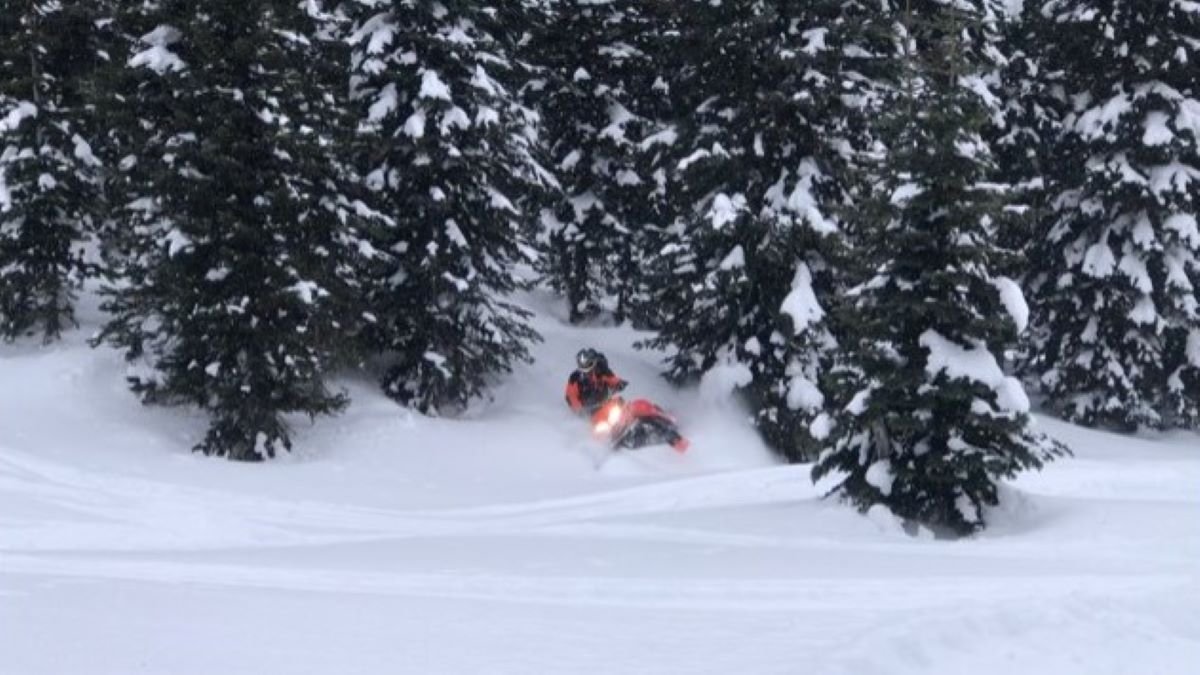Stranded Snowbikers Rescued After Getting Stuck in Ravine

February 28, 2020
What started out as a fairly routine backcountry freeride on snowbikes — dirt bikes with ski and track conversions designed for deep snow — turned into an unexpected situation that left Craig Hunter and three other party members stranded in a deep ravine in freezing temperatures. In his own words, Hunter shared with Garmin the details of their 40-hour ordeal, SOS, night in the woods and rescue in the Canadian Chic Chocs. Plus, the snowmobile dealer shared what he learned from the trying experience.
“A few members of our group dropped over a ridge into a
section of steep trees that should have been easily rideable if the snow was
different. However, that day, the snow was super powdery, bottomless and
filled with buried pine trees. These trees hold pockets of air under their
branches when buried in snow, so when you ride near them or over them, the
bikes sink immediately — sometimes
6’ to 8’.
One of my party members had ridden this mountain before, but
it was later in the season when the snow was more set up, and therefore
provided more floatation and traction. The trees had also been packed more
tightly then, so the invisible air pockets and tree holes were not a concern.
This time, he got stuck.
I had followed him into the steep, treed slope to help him
get unstuck, but it became obvious that turning around and going upwards and out
the way we came in would not be possible. He believed there was a trail along
the top of the mountain that gradually sloped down, so if we continued
horizontally across the mountain, we would intersect the trail and ride out.
So the four of us continued along the very steep slope,
occasionally encountering deep tree holes that would completely swallow the
bikes. The tree line was dense at the top, so riding through it wasn’t possible,
and it gradually forced us downhill into a river bed. There, we decided to head
for a ‘trail’ we saw on the GPS that would hopefully lead us to an old access
road and out.
We battled the creek bottom, open water, tons of sticks,
trees, dead ends and more —
well past dark. At one point we found
some snowmobile tracks in the ravine and followed them in circles for over an
hour, but could not locate a route in or out of the ravine. It was snowing hard
at this point, and the tracks eventually disappeared. When we ventured off
the side of the river, the brush and trees were too dense to make much
progress, so we kept getting forced back onto the partially snow-covered river.
The sides of the ravine were too steep, deep and dense to
get out. The way we came in was not an option, and the way we were heading dead
ended everywhere we looked. Progress was slow and exhausting, and we had been
riding, digging, cutting branches and lifting the bikes for over 12 hours at
this point. Two of us had bright, battery-powered helmet lights, but the other
two had no lights. Eventually one party member began to have cramping and abdominal
pain.
The river banks were getting steeper, the lines we were forced to take were getting riskier, and chances that one of us would make a mistake and end up in the water were getting higher. All four of us are very experienced backcountry motorcycle and snowmobile riders who have ridden all over the United States and Canadian mountains, but it became clear that we weren’t going to be able to ride out of this situation — at least not in the dark after a strenuous day of riding and digging.

Eventually —
wet, exhausted and almost out of gas — we decided to set up camp and try again in the morning.
It was 0 degrees and still snowing.
We stopped next to a large downed tree whose end was
suspended about 4’ off the ground. We dug down to the ground under the tree to
make a base for the fire so it would not melt down into the snow. Using birch bark for tinder and a lighter, we
started a fire. To keep the fire going over the next 24 hours, we never stopped
cutting wood with my Corona folding limb. We used a shovel to cut blocks of
snow to build up walls and used some 4” round trees to provide support for a
pine bough roof. A 10” x 5’ long log was our seat for the night — until we had to burn
it.
While preparing the camp, I heard my inReach Mini satellite communicator chime. I had reluctantly — and at the request of my wife — gotten the device just a few weeks before. I almost didn’t get one because many of the places we ride in the western mountains have cellphone service, and a few of my riding buddies already have an inReach device. However those buddies were not on this trip.
The chime was a message was from my wife who hadn’t heard
from us and wasn’t able to reach me on my cellphone. I used the device to
inform her that we were OK, but would be spending the night in the woods. The
primary task at the time was ensuring that we had a stable fire and shelter
before the…
